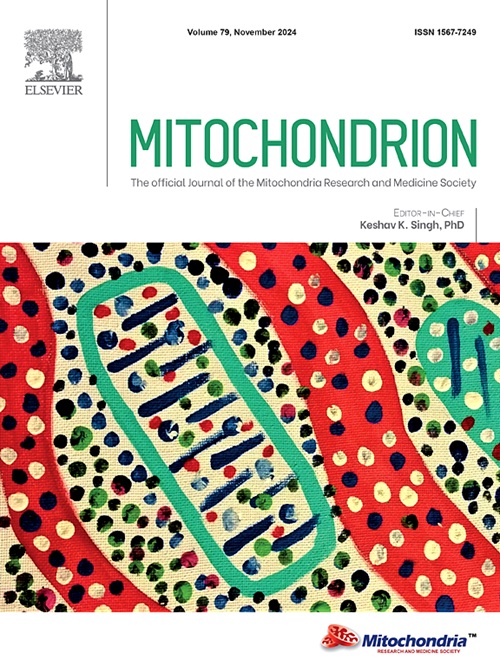Cell-specific mitochondrial response in progressive supranuclear palsy
IF 4.5
3区 生物学
Q2 CELL BIOLOGY
引用次数: 0
Abstract
Progressive supranuclear palsy (PSP) is a main form of idiopathic tauopathy characterized neuropathologically by subcortical neurofibrillary tangles in neurons, oligodendroglial coiled bodies, and tufted astrocytes, which follow sequential distribution in the human brain. Mitochondrial dysfunction is thought to be a contributor to many neurodegenerative diseases, but its role in PSP at the cellular level remains incompletely understood. To address this, we performed cell-specific morphometric analysis of mitochondrial markers in post-mortem tissues from motor cortex of PSP patients and non-diseased controls (n = 5 each) followed by single-nuclear transcriptomics (n = 3 each) to identify changes in genes that regulate mitochondrial function. We treated iCell astrocytes with PSP brain homogenates and isolated viable astrocytes from multiple regions of PSP-affected brains. We found that PSP is characterized by significant mitochondrial changes in neurons and astrocytes at the immunohistochemical level, particularly in complex I, with distinct transcriptomic responses across cell types. Glial cells exhibited upregulation of pathways associated with mitochondrial function. In contrast, excitatory and inhibitory neurons showed downregulation in these pathways, indicating impaired mitochondrial function. Astrocytes derived from different human brain regions express varied levels of GFAP and EAAT1 immunoreactivity. Astrocytic tau pathology in cell culture derived from postmortem PSP brains mirrors that seen in corresponding brain tissue histology. Tau pathology in human astrocyte cell culture is associated with clumps of mitochondria potentially associated with impairment in their neuron supportive function. Our results underscore selective complex I damage and cell-type specific patterns that differentiate PSP from other neurodegenerative diseases.
进行性核上性麻痹的细胞特异性线粒体反应
进行性核上麻痹(PSP)是特发性脑病的一种主要形式,其神经病理学特征是神经元皮层下神经原纤维缠结、少突胶质卷曲体和丛状星形胶质细胞,它们在人脑中顺序分布。线粒体功能障碍被认为是许多神经退行性疾病的一个因素,但其在PSP细胞水平上的作用仍不完全清楚。为了解决这个问题,我们对PSP患者和非患病对照组(各n = 5)的死后组织中的线粒体标记物进行了细胞特异性形态计量学分析,然后进行了单核转录组学(各n = 3),以确定调节线粒体功能的基因的变化。我们用PSP脑匀浆处理iCell星形胶质细胞,并从PSP脑的多个区域分离出有活力的星形胶质细胞。我们发现PSP的特点是在免疫组织化学水平上神经元和星形胶质细胞的线粒体发生显著变化,特别是在复合物I中,不同细胞类型的转录组反应不同。胶质细胞表现出与线粒体功能相关的通路上调。相反,兴奋性和抑制性神经元在这些通路中表现出下调,表明线粒体功能受损。来源于人脑不同区域的星形胶质细胞表达不同水平的GFAP和EAAT1免疫反应性。死后PSP脑细胞培养的星形细胞tau病理学反映了相应的脑组织组织学。人类星形胶质细胞培养中的Tau病理与线粒体团块可能与神经元支持功能受损相关。我们的结果强调了选择性复合物I损伤和细胞类型特异性模式,将PSP与其他神经退行性疾病区分开来。
本文章由计算机程序翻译,如有差异,请以英文原文为准。
求助全文
约1分钟内获得全文
求助全文
来源期刊

Mitochondrion
生物-细胞生物学
CiteScore
9.40
自引率
4.50%
发文量
86
审稿时长
13.6 weeks
期刊介绍:
Mitochondrion is a definitive, high profile, peer-reviewed international research journal. The scope of Mitochondrion is broad, reporting on basic science of mitochondria from all organisms and from basic research to pathology and clinical aspects of mitochondrial diseases. The journal welcomes original contributions from investigators working in diverse sub-disciplines such as evolution, biophysics, biochemistry, molecular and cell biology, genetics, pharmacology, toxicology, forensic science, programmed cell death, aging, cancer and clinical features of mitochondrial diseases.
 求助内容:
求助内容: 应助结果提醒方式:
应助结果提醒方式:


